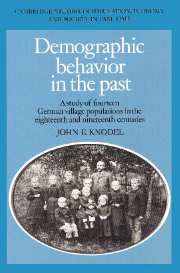 Demographic Behavior in the Past
Demographic Behavior in the Past Book contents
- Frontmatter
- Contents
- List of tables
- List of figures
- Acknowledgements
- PART I INTRODUCTION
- PART II MORTALITY
- PART III FAMILY FORMATION
- PART IV MARITAL REPRODUCTION
- PART V INTERRELATIONSHIPS IN DEMOGRAPHIC BEHAVIOR
- PART VI CONCLUSION
- Appendices
- A Selection of couples for analysis
- B Assessment of the quality of demographic data contained in German village genealogies
- C Local village conditions
- D The occupational and status classification schemes
- E Calculation of infant and child mortality risks
- F Prevailing infant-feeding patterns
- G Evidence of biases in the determination of legitimization status
- Bibliography
- Index
A - Selection of couples for analysis
Published online by Cambridge University Press: 04 August 2010
- Frontmatter
- Contents
- List of tables
- List of figures
- Acknowledgements
- PART I INTRODUCTION
- PART II MORTALITY
- PART III FAMILY FORMATION
- PART IV MARITAL REPRODUCTION
- PART V INTERRELATIONSHIPS IN DEMOGRAPHIC BEHAVIOR
- PART VI CONCLUSION
- Appendices
- A Selection of couples for analysis
- B Assessment of the quality of demographic data contained in German village genealogies
- C Local village conditions
- D The occupational and status classification schemes
- E Calculation of infant and child mortality risks
- F Prevailing infant-feeding patterns
- G Evidence of biases in the determination of legitimization status
- Bibliography
- Index
Summary
The histories of vital events for individual couples are often incomplete and unusable for demographic analysis since the village genealogies include any family (or individual person if he or she cannot be linked to a family unit) that has at least one event entered in the local registers. By coding only couples for whom at least some prespecified minimum amount of information is available, substantial savings in time and effort can be effected at the data preparation stage. For the present study, 6 of the 14 village genealogies in the sample were coded completely (Braunsen, Kappel, Massenhausen, Middels, Öschelbronn, and Rust), while only preselected couples were coded for the remainder. In addition, a more detailed coding scheme was used for the villages in which all couples were coded. In the present study, for the large majority of purposes only those families from the fully-coded villages are included which meet the same minimum tests of completeness that were applied to the villages for which couples were preselected. Thus for most practical purposes the same selection of cases was involved for all 14 villages in the sample.
Criteria for initial selection
Given the considerable attention focused on reproductive behavior in this study, the criteria for selection were chosen such that most couples for whom there was insufficient information to permit their use for fertility analyses were excluded.
- Type
- Chapter
- Information
- Demographic Behavior in the PastA Study of Fourteen German Village Populations in the Eighteenth and Nineteenth Centuries, pp. 461 - 477Publisher: Cambridge University PressPrint publication year: 1988


